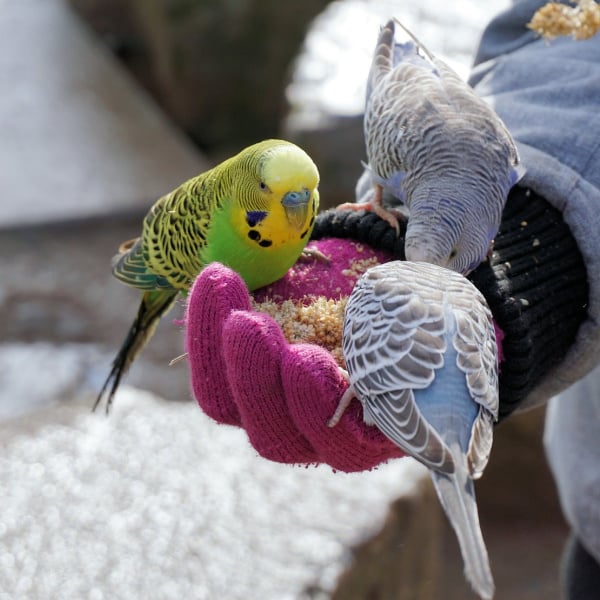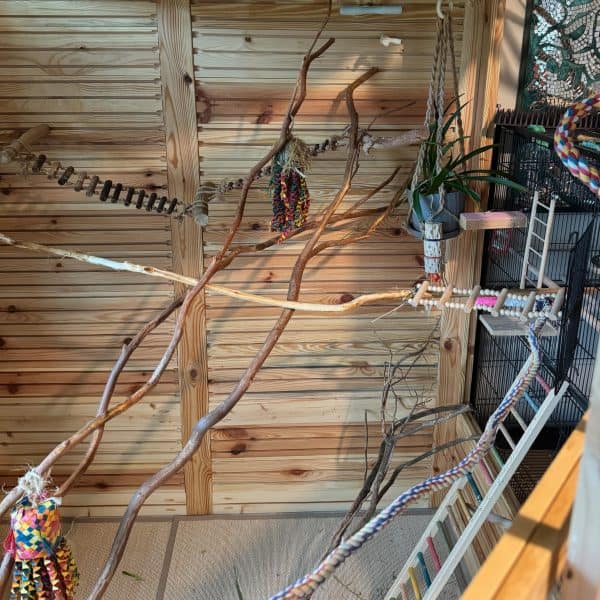Last Updated on by Mitch Rezman
One of the first things I evaluate with a problem bird is their cage. Where it is located, size, shape, and how it is set up.
Many behavior problems can be attributed to having your parrot in improper surroundings. Their cage should be a safe haven for them with plenty of things to keep them busy.
A good birdcage should be easy to keep clean, and it should not be round. The bar spacing should be appropriate for the type of bird or parrot that is housed in it.
Whether or not you have a play top bird cage or a dome top parrot cage is up to you. One of the best gifts you can give yourself and your parrot is a top-of-the-line cage.
When you skimp on a bird cage you just end up replacing it again and again. Do your research and get a cage that will last the lifetime of your parrot.
Bird Cage Placement
The birdcage should be placed in an area where you are sure your parrot will be able to view his surroundings safely without feeling threatened.
You do not want to place a parrot cage directly in front of a window or in the center of a room. Our first response is to assume that they would enjoy the outside view or being right in the middle of a room so they can see everything.
The truth is that this type of placement may be fine while your parrot is young. But once your parrot becomes sexually mature and aware that it is a prey animal, this type of placement will cause extreme stress upon him.
Knowing this, a parrot should be placed against a solid wall, if this is not possible then the back half of the parrot cage should be covered at all times. This will give him the sense of security that is needed.
Parrots do not live out in the open in the wild. They live inside trees in dense forest areas, under rocks, and even burrow into the ground.
So they may live and raise their young safely. Therefore we should try to mimic this type of environment by placing the birdcage in a more indiscreet area or our homes.
One where they can take pleasure in their surroundings and not feel threatened. You will need also to consider your parrot’s sleep requirements. Does the placement of the cage allow for the proper amounts of undisturbed quiet and darkness?
If not do you have a sleeping cage in another room? Sleep deprivation is a problem with many parrots I see. So if your parrot is not receiving at least ten to twelve hours of rest each night you will need to re-evaluate his cage placement.
Do’s and dont’s for bird cage placement
- Don’t place a birdcage directly in front of a window
- Don’t place a birdcage in the center of a room
- Don’t place a birdcage right on the edge of a doorway
- Don’t place a birdcage next to the TV that is watched late into the nite
- Don’t place a birdcage in the kitchen because of toxic fumes
- Don’t place a birdcage in an unfinished basement
- Don’t place a birdcage in a utility room
- Don’t place a birdcage in the garage
- Don’t place a birdcage in your bedroom
- Do place them in a corner of the family room with a sleeping cage in another room
- Do place them in a frequently used office or sitting room
- Do have a bird room if you have multiple birds
- Do place it in an alcove or visible dining room
- Do place them against a wall
- Do place them so they have a view of the entire room without putting them as a focal point.
- You want your parrot to be able to observe his environment so he learns to trust his surroundings yet still be within the family circle.
There should be three different size perches in the bird’s cage. These perches should also have different textures with at least one of the perches being a rope or Booda perch. The rope perch should be the one that is placed at the highest point for sleeping.
Place this perch in a U shape in the upper back corner of the cage. This is especially important if you have a feather picker. It gives a sense of safety to the parrot, plus if they turn to pick, the rope is right there and they will opt to shred that.
The other two perches should be wood or one wood of a different texture of choice. I would also like to add that there does not have to be perches in front of every food dish. We tend to make life just a little too easy for these busy birds. Make them work a little.
Bird Cage Set up
Three different perches with the main wood one going horizontally across the middle. The rope perch should be in a U shape in the upper back corner.
The third should be placed just inside the door so that when the door is opened the perch is brought out of the cage.
By doing this you do not have to reach into the cage for step-up commands that may be refused. When you want your parrot to come out you have him come down to this perch first, open the door once he is on it, and request the step up. This is a must if your bird has aggression issues.
Now it is time to add the toys. Good toys have many different shapes and textures for the bird to explore and destroy.
Your parrot should have a minimum of ten toys in his cage at all times. You should not be able to see the parrot easily when he is in his cage. This is his home and he should feel camouflaged as he would if he was in the wild.
Place one of the working toys in front of the U shape perch, with the other working toy towards the front of the opposite corner.
Place one of the other toys directly on the side of the U perch so that perch is surrounded by hanging toys.
This allows your parrot a hiding place to feel secure. Now take paper towels, shredders, newspaper, leather, or brown paper bags and fold them up and weave them into the cage bars making a little square section on the side and to the back of the U perch.
Again this gives a sense of security to the parrot. Plus if you have a feather picker it gives them another option to chew instead of their feathers.
We have to remember that we took these birds from the wild and it is up to us to learn to understand their needs. Set their cage up in a way that is fun for them and keep it interesting. Busy beaks are happy beaks!
Thank You,
Michelle Karras
Published Birds USA
Lecturer
Slave to Twelve rescued Parrots
Your Zygodactyl Footnote
Author Profile
Latest entries
 The Traveling BirdJune 26, 2025Can You Name 5 Parrot Species That Are Living Wild in the USA?
The Traveling BirdJune 26, 2025Can You Name 5 Parrot Species That Are Living Wild in the USA? Bird BehaviorJune 26, 2025How is it Parrots Are Problem Solvers Social Animals and Even Use Tools?
Bird BehaviorJune 26, 2025How is it Parrots Are Problem Solvers Social Animals and Even Use Tools? Bird & Parrot AnatomyJune 25, 2025How a Tiny Chemical Modification Makes Parrots Nature’s Living Paintings
Bird & Parrot AnatomyJune 25, 2025How a Tiny Chemical Modification Makes Parrots Nature’s Living Paintings PigeonsJune 20, 2025How Do Parrots Thrive in Cities Outside Their Native Habitats?
PigeonsJune 20, 2025How Do Parrots Thrive in Cities Outside Their Native Habitats?





Lisa
2 Oct 2016Good article, thank you!
WindyCityParrot
7 Oct 2016no thank you for the kind words Lisa
WindyCityParrot
5 Oct 2016this a readers post”
I want to respond to the article on cage placement but had trouble doing so on your blog. Our sun conure’s cage has been in a corner window for 18 years.
The windows are fixed (don’t open) and we are in Southern California, so it is never cold for her, but she loves being there. She looks out onto our patio, watches us when we are in the yard, has a great view of the hummingbirds at their feeder and is not bothered any longer by airplanes in the distance ~ something that did startle her when she was young.
She gets afternoon sun (and vitamin D), and it is her little corner of our house. The room is the dining area of our kitchen, but is at least 20+ feet from the cooking area and it is right next to the table where we eat breakfast and dinner, so she is a part of our daily lives.
The room is also open to the family room where she spends each evening with us out of her cage. Her cage is more than 17 feet from the TV (recommended by the conure book) so we think we’ve done everything right.
About moths in bird seed. We had that problem in the past when, for the first time, we didn’t freeze new seed bags for at least 24 hours before using them.
Everything gets frozen first now. But, the moths are still in the air. We set traps which work well, but constant vacuumingRegarding the moths in the seed – unless you’re freezing in a deep chest freezer the larva are only being suspended and not killed by the cold. The typical household refrigerator freezer is not cold enough to kill the larva – FYI up seed both from the crevices of the cage and the floor is essential.
Diane
WindyCityParrot
5 Oct 2016Hi Diane,
Sorry about the problems with posting – one does need to be logged in to disqus it is how we keep spam down
Small note -> your bird is not getting any additional vitamin D from being in front of the window – we talk about that here: https://goo.gl/sgf8DH also be aware that all household glass filters out all UVA and UVB light.
That said it sounds like you have everything going for you and if it’s working please don’t try to fix anything.
As for her being startled – is not surprising because your conure may see the occasional raptor – anything from a hawk to a vulture and in Southern California perhaps even a Condor
Best of luck
I have posted your comment and my reply on our blog
mitchr